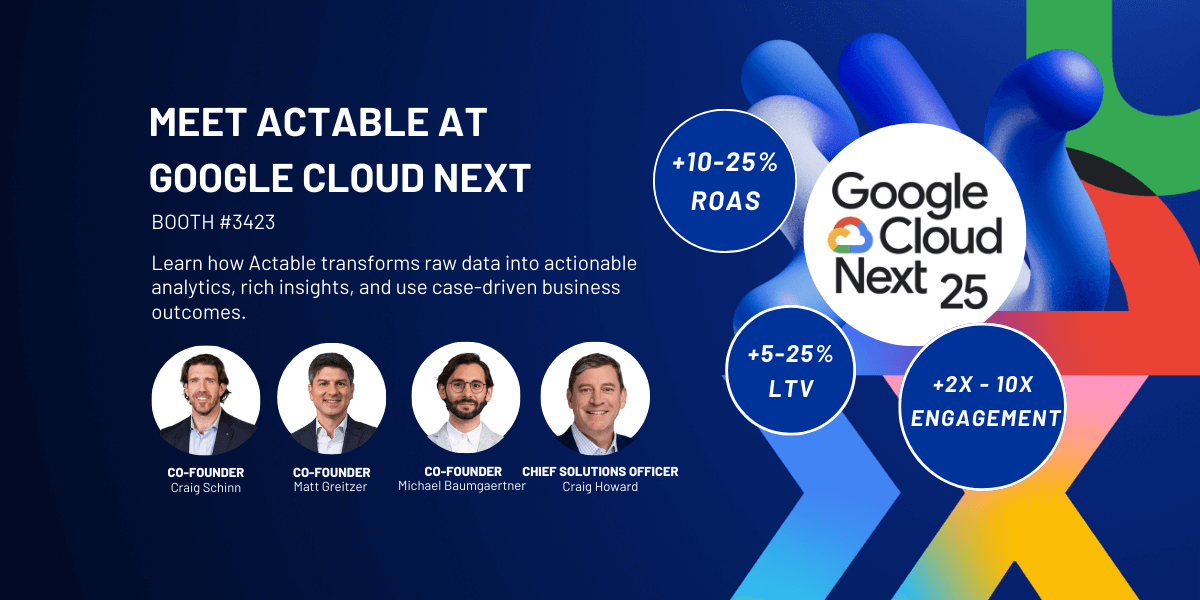Actable co-founder Michael Baumgaertner reflects on the shifting use cases for 3rd party data, and discusses how it remains a valuable asset worth exploring for smart marketers.
3rd party data isn’t new, but that doesn’t mean it’s obsolete.
For decades, marketers have relied on 3rd party data as an essential tool for insights generation and message targeting, across many marketing channels, and with varying degrees of sophistication. In the cookie-dominated digital marketplace of the last decade, 3rd party data was elevated to the status of a fundamental instrument for the purposes of targeting, owing to its easy access point and massive scale. As cookies fade away, and consumer attitudes toward targeted advertising shift (not in a positive direction!), it’s a good time to reevaluate what the right way to use 3rd party data is, and what benefits it offers in an increasingly 1st party data-oriented world.
So what is its value in today’s 1st-party dominant world?
The short answer? Very valuable! While there is no argument that for the majority of marketers, 1st party data is far and away the most valuable source available, it rarely if ever manages to build as rich a picture of the customer as can be painted when data points not available in the 1st party set are included. Typically valuable information for modern marketers might include mobile-specific data points, tv viewership, purchase history, etc, all of which wouldn’t be available 1st party. The question is how to intelligently deploy these data points, since inefficient activation erases benefits with cost overruns. This is where marketers often stumble with 3rd party data. On its own, and increasingly when used as a targeting criteria, 3rd party data just doesn’t perform efficiently enough to justify the cost. Worse yet, when used as a stand-alone insights tool, there is little to no applicability of the findings into a marketing plan, since the data set is completely siloed off from the activation currencies in most channels.
So, if it has value, how should it be used?
With the advent of advanced user-matching services and data transformation tools, the opportunity to use 3rd party data primarily as a signal generator and not a targeting criteria is more present than ever. Whereas in the past, analysis was limited by static data sets, cumbersome onboarding and manipulation processes, and often data poverty on the marketer side, now many marketers are able to quickly match their 1st party data into 3rd party data sets. There are three related but significant use cases that emerge from this ground-up approach that starts with 1st party data:
- Actionable insights: when using a first party data set as a starting point from which to analyze a 3rd party data set, the findings tie directly to your known customer data. This means that trends and findings within the 3rd party data set are tied to a set of identifiers that are directly actionable in the preexisting marketing systems that utilize them (email, ads, site experience, CRM, SMS, etc.)
- Net new performance signals: the chance to unearth powerful performance signals is a related and significant opportunity for marketers. By identifying 3rd party characteristics otherwise invisible on the basis of the known customer record, marketers can segment their audiences according to shared predictive traits, and form new audiences who are addressable with even more relevant and tailored messaging built around those traits
- Strategic and informed acquisition: since the process of matching 1st and 3rd party data almost always matches a smaller audience with a larger one, the opportunity to discover net-new customers within a 3rd party set that match your most valuable customer profiles is as appealing as ever. A simple use case, such as look-a-likes, is easy enough to execute, but increasingly marketers are blending multiple data sets together to interlace 1st party predictive signals and 3rd party data signals and deploy out a complex acquisition model built from various data sources into relevant channels
But before I invest, is it worth the price?
Depending on how you end up working with a 3rd party vendor, a variety of cost models may apply, but most can work with you to “try before you buy” and go through a discovery process to determine how well-suited their data set is to your customer base. Ideally, you are able to apply similar modeling/customer scoring techniques to the data sets you’re accessing to see which can deliver the strongest predictive signals, but either way, it is smart to optimize your consumption up front, and purchase only the data you need. One thing is for sure – in these price sensitive times, optimizing your 1st party data can deliver significant savings on deployment and efficiency – so the investment in 3rd party data that powers that may well be worth it.
What to watch out for as you get started:
When working with 3rd party vendors, there are a few things to keep in mind that can trip up the process, producing cumbersome workflows, or worse yet, poor return on investment. It’s important to make sure that your internal data assets and your data provider’s data systems are compatible, and to engage an intermediary if they are not. Once you’ve made sure that your owned data can play nice with the 3rd party set you want to access, make sure that there is a good match rate or prevalence; if you go too far down the path with a provider only to discover that low prevalence makes the set unusable, the entire exercise will have been for naught! Last but not least, make sure you have a protocol in place to keep data flowing between systems, in case there are any downstream dependencies in your marketing stack, and for the sake of freshness, so that your intelligence is as current as it can be based on what the data provider has.









